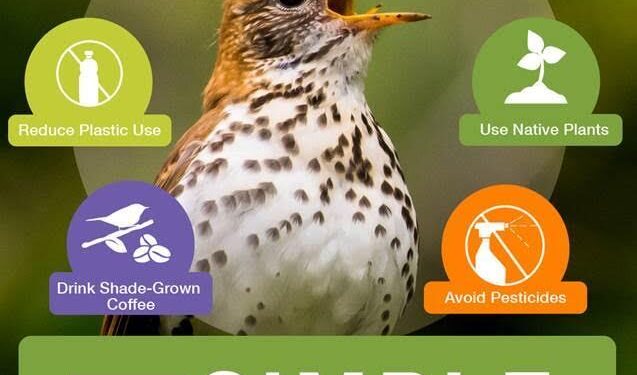A new study published in Nature highlights the urgent need to pair threat reduction efforts with targeted recovery programs to safeguard the world’s diverse bird populations. As habitat loss, climate change, and human activities continue to push numerous bird species toward extinction, researchers emphasize that simply mitigating threats is no longer enough. Effective conservation strategies must also include focused initiatives to restore vulnerable species and their habitats, signaling a pivotal shift in global biodiversity preservation efforts.
Urgent Need to Address Key Threats Driving Global Bird Declines
Global bird populations are plummeting at an unprecedented rate due to a convergence of critical threats that demand immediate, coordinated action. Habitat loss from deforestation and urban expansion continues to erode essential breeding and feeding grounds. Simultaneously, intensified agricultural practices introduce pesticides that disrupt food chains, while climate change alters migration patterns and breeding cycles, exacerbating vulnerabilities. Without swift intervention, many iconic and ecologically vital species face irreversible declines.
Effective conservation strategies must combine threat reduction with proactive recovery initiatives targeting species at greatest risk. This dual approach should include:
- Habitat restoration and legal protection to safeguard key ecosystems
- Community engagement programs fostering local stewardship
- Scientific monitoring and adaptive management to track progress and inform policy
- Captive breeding and reintroduction efforts for severely endangered species
| Threat | Impact on Birds | Recommended Action |
|---|---|---|
| Habitat Destruction | Loss of nesting and foraging sites | Expand protected areas & rehabilitation |
| Pesticide Use | Food chain contamination | Promote sustainable farming |
| Climate Change | Altered migration & breeding | Integrate climate resilience |
Integrating Habitat Restoration and Species-Specific Recovery Efforts
Effective conservation of avian populations requires a multifaceted approach that marries broad-scale habitat restoration with tailored species recovery strategies. While rehabilitating degraded ecosystems lays the foundation for sustainable bird habitats, it is the incorporation of species-specific recovery efforts that ensures the survival of the most vulnerable populations. These efforts may include captive breeding, genetic diversity management, and controlling invasive species that threaten endemic birds. By addressing both ecosystem health and individual species needs, conservationists create resilient environments where birds can thrive without constant human intervention.
Collaborative frameworks that integrate these dual approaches have proven successful in various regions. Key components of this integrated model include:
- Restoration of native vegetation and wetlands to rebuild natural food webs
- Targeted monitoring programs tracking population dynamics of threatened species
- Community engagement initiatives promoting coexistence and reducing human-wildlife conflicts
| Recovery Approach | Target Species | Outcome |
|---|---|---|
| Wetland Restoration | Marsh Harrier | Population increase by 25% in 5 years |
| Captive Breeding | California Condor | Reintroduction of 50 individuals in wild |
| Invasive Predator Control | Pomarine Jaeger | Breeding success improved by 40% |
Policy Recommendations for Coordinated Conservation and Community Engagement
Effective conservation strategies demand a multifaceted approach that integrates habitat protection with the active involvement of local communities. Policies should prioritize establishing collaborative frameworks where indigenous knowledge and community stewardship complement scientific recovery efforts. Empowering communities with education, economic incentives, and participatory decision-making not only ensures sustainable habitat management but also reduces human-induced threats such as poaching and habitat encroachment.
To operationalize these strategies, governments and NGOs must adopt clear guidelines focusing on:
- Community-led monitoring: Supporting local groups in tracking bird populations and reporting threats in real-time.
- Incentivized conservation: Providing financial benefits or alternative livelihoods linked to conservation success.
- Restoration priorities: Allocating resources towards rehabilitating critical breeding and migratory habitats.
- Cross-sector collaboration: Integrating policies across agriculture, forestry, and urban development to minimize conflicting land uses.
| Policy Action | Expected Outcome | Community Role |
|---|---|---|
| Local Conservation Councils | Improved habitat surveillance | Leadership & Reporting |
| Eco-tourism Initiatives | Economic incentives for protection | Service Providers & Guides |
| Habitat Restoration Grants | Enhanced breeding success | Active participation in rehabilitation |
| Legal Enforcement & Training | Reduced illegal activities | Community Watch Groups |
Future Outlook
As global bird populations continue to face mounting pressures from habitat loss, climate change, and human activities, experts emphasize that simply curbing threats is not enough. The latest research published in Nature underscores the urgent need for targeted recovery programs tailored to vulnerable species and regions. Combining threat reduction with strategic conservation efforts offers the most promising path to safeguarding the rich diversity of the world’s avian life. Without this dual approach, the future of many bird species-and the ecosystems they support-remains uncertain.

















![[News] China Makes Breakthrough in Chip Technology, Paving the Way for Lithography Advancements – TrendForce](https://earth-news.info/wp-content/uploads/2025/11/324664-news-china-makes-breakthrough-in-chip-technology-paving-the-way-for-lithography-advancements-trendforce-360x180.jpg)












